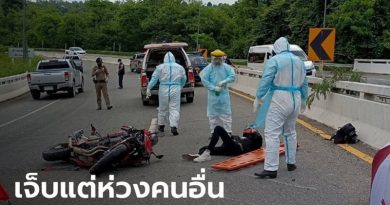Asia cancer cases jump but cure elusive
AS far as making New Year resolutions go, switching to a healthy diet, exercise, adequate sleep and less stress can lower your chances of developing cancer, doctors recommended at the Esmo Oncology (cancer treatment) symposium in Singapore.
Thailand is among the countries facing higher cancer cases, warned Dr Pichai Chansriwong of Ramathibodi Hospital.
Along with hundreds of top medical researchers at the convention, he admitted a cure remains elusive as cancer comes in many forms and variations.
“We tell people to adopt a healthy lifestyle as the best preventive means of fighting the disease.”

Researchers find cancer does not attack everyone the same way. Detection is sometimes hard. If it is not caught early at Stage 1 or 2 phases, chances of survival drops.
“The three biggest killers in Thailand are liver, lung and breast cancer,” says Pichai who also lectures at Mahidol Univesity.
Younger people today are treated for the disease that used to mainly affect the old.
“The youngest we had was an 11-year-old boy, He had bone cancer. It was detected late and he died shortly after admission.”
According to IMS Research, 55 per cent of cancer cases today are in the Asia-Pacific region.
While rich Asian countries have more cancer cases, the fatality rate among the poorer nations are doubled theirs.
The rise in cancer among urbanized societies come from an unhealthy lifestyle of junk food, accelerated stress levels, sleep deprivation and other self-induced abuses to the body.
In poor countries, late detection and high cost of treatment (which is not reimbursed by government), means many patients die.
China cancer fatalities top 70% and India has 68%, the IMS study found. Of the 124,000 cases in Thailand, 85,000 expire.
Some Thai cancers are also different. The form of liver cancer here, called “liver-fluke” is unique as it is caused by parasitic organisms.
“It is also found in Laos, Cambodia and Vietnam, countries bordering the Mekong River,” said Pichai. “But rare elsewhere.”
“But it is easy to avoid, don’t eat raw fresh water fish from paddy fields that carry the parasite. Just cook it.”
Many people, however, refuse to give up the ‘pla dip’ dish despite state educational attempts, and this contributes to the growing number of cases.
Doctors at the symposium shared new information pointing to Asia bearing the brunt of the cancer scourge.
As more Asians migrate to cities and are living longer, cancer will soon be their greatest problem.
Also more women are joining the workforce and suffer stress at work, poor diets and lack of exercise, raising the risks of developing cancer.
Australia has the highest cases of breast cancer among Pacific countries with 86 women per 100,000; followed by Singapore with 66 and Taiwan with 65, a recent survey by The Economist said.
In Hong Kong, 61 women per 100,000 have the disease while Japan and South Korea have 52 cases each. Thailand has 29 cases but it is the third highest for countries that show the fastest cancer growth of 34% a year.
Malaysia, saw the sharpest rise with 49% followed by Singapore with 37%.
Because of its population size, China has the largest cancer cases with 3 million patients, of which 2 million will perish.
Asians were found to do almost anything for a cure.
Hong Kong researcher Dr Janice Tsang said almost all her patients consult traditional Chinese medicine practitioners while undergoing treatment.
Whether that works remains unknown as empirical studies for such cases have yet to be established, she said.
One bright spot in the grim outlook was a breast cancer drug called Ibrance by Pfizer. It can prolong life in late stage patients, and extend life by 2 to 5 years.
Dr Wong Seng Weng of Singapore’s Cancer Center said only 60% of cancer patients survive after being diagnosed. “10% die because of late detection and 30% succumb as it spreads through the body.
“A drug like Ibrance makes a big difference for those in the final stages.
They live a normal, quality life as the inhibitor drug blocks the spread without using chemotherapy, a radiation process that brings on bad side effects.
“For those mothers with young children. Being given 2 extra years means they get to celebrate more birthdays with the kids.”
“It also brings great relief to care givers, usually the family members, if the patient leads a normal life.”
Ibrance is considered a breakthrough because it offers a new path for treatment without requiring chemotherapy that kills both harmful cells as well as healthy ones.
Some doctors say such cures can be worse than the disease itself.
In many cases, patient can die from the side effects.
In October, Thailand became the latest country to approve Ibrance.
“The drug taken orally as capsules. Without chemotherapy, the treatment allows patients to lead normal, productive lives,” he said.
The drug is not cheap, costing about 100,000 baht a month or 1.2 million baht a year.
In some special cases, Pfizer offers a free 1-month trial.
Chemotherapy will continue to serve as a cheaper form of treatment. It will be used until generic forms come on the market.
Other pharmaceutical giants are develop Ibrance-like drugs. Novartis and Eli Lilly are developing CDK 4/6 inhibitors to treat breast cancer and other forms of cancer.
CAPTIONS:
Top: Dr Pichai Chansriwong of Ramathibodi Hospital says cancer cases in Thailand, like much of Asia, is sharply rising.
In-text: The Esmo Oncology cancer treatment symposium in Singapore drew thousands of doctors and medical researchers
By Cimi Suchontan



